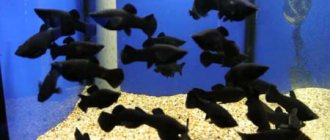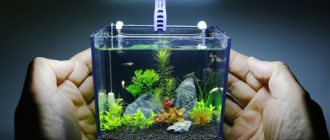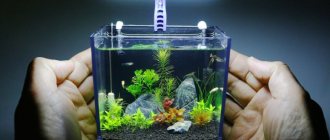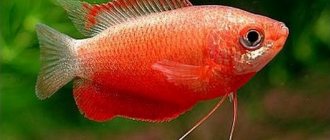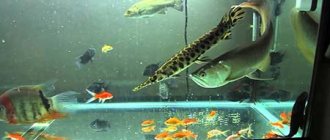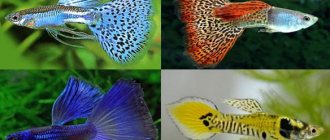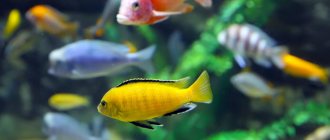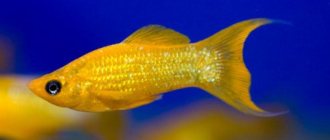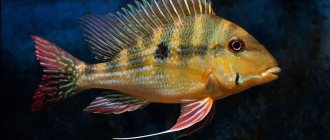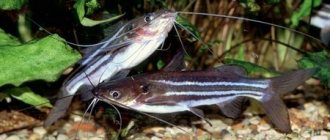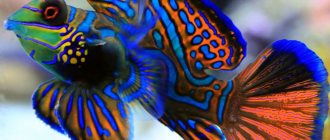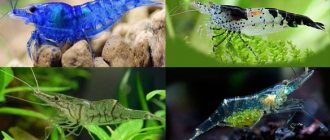Aeration systems occupy an important place among aquarium equipment. They provide oxygen into the water, which is necessary for fish to breathe. However, they are often noisy, expensive, require a free outlet and space for installation, and produce vibration. Therefore, many novice aquarists strive to have fish that live without oxygen in the aquarium. Such fish are easy to find on sale, and they are not difficult to care for and maintain.
What aquarium fish can be kept without oxygen?
Dmitry
If you mean oxygen in water, and not oxygen in general, then these are any representatives of the Labyrinthine Family. Labyrinth fish are known for their ability to breathe atmospheric air. For these purposes, they have a special organ called the labyrinth (this organ gave the second name to the Belontiidae family - labyrinths). The labyrinth is located directly above the gills, in small depressions on either side of the head. Fish swallow atmospheric air at the surface of the water and place it in the spongy chambers of the labyrinth, the walls of which are penetrated by a network of blood vessels.
This extra breathing is vital for them - if these aquarium fish are denied access to the surface (for example, the cover glass touches the surface of the water), then they may die. Scientists divide the labyrinths into four families: Anabass (Anabantidae) with the genera: Anabas, Sandelia and Ctenopoma; macropods (Belontiidae) with the genera: Betta, Belontia, Ctenops, Colisa, Malpulluta, Parosphronemus, Pseudosphronemus, Sphaerichthys, Trichogaster ), trichopsis (Trichopsis) and trichoptera (Trishopterus); Helostoma, which includes one genus Helostoma; and - true gouramis, also with the same genus Osphronemus. The most common aquarium fish of the labyrinthine family is the marbled gourami or common gourami.
Anyutka =)
Labyrinthids (barbs, cockerels, laliuses, belontia, ctenopoma, macropods, gourami...). Golden ones definitely need oxygen! The cockerels are very beautiful)) )
Selection rules
Unpretentious fish for the aquarium are selected taking into account the following characteristics:
- Compatibility of temperaments. Look at the habits of a certain type so that conflicts do not arise.
- Required conditions. For proper settlement, the requirements for the habitat are taken into account. Comfortable temperature, acidity level and water hardness are considered.
- Adult size. Having a clear idea of what size the fish will reach will protect you from a common mistake.
- Schooling Most small fish in their natural environment live in schools. For the well-being of pets, several individuals are accommodated.
- Eating Habits The inhabitants of a body of water feed at different levels: those who feed at the surface of the water and those who obtain food from the bottom. An ill-conceived nutrition system has a detrimental effect on the health of pets.
Compatibility
Introduce aquarium inhabitants similar in character. Predators and aggressive large fish should not be placed with small peaceful species. Even calm, large inhabitants can inadvertently eat small ones. Mobile schooling fish will be bad neighbors for calm and slow species.
Number of fish for settlement
Universal rules for determining quantity:
- The aquarium population is selected based on the net volume of water. 10–15% of the space spent on decorations, plants and soil are not taken into account.
- Large fish are placed in a spacious aquarium. For small, active and social animals you will need a container of 40 liters or more.
- The calculation is based on oxygen exchange. If there are plants and additional sources of oxygen, then the number of inhabitants of the aquarium increases. To dissolve oxygen, the water temperature rises. Overpopulation is indicated by the concentration of fish near the surface even with good aeration.
- The larger the fish, the more waste it produces. To determine the permissible number of inhabitants, measure the level of nitrogen compounds and impurities in the water. Water tests are purchased at pet stores.
- In a mixed-sex aquarium, the number of females is 2-3 times greater than males.
These recommendations do not take into account the characteristics of individual representatives. Each aquarist must select the number of fish himself, monitoring the behavior of his fish and creating the maximum level of comfort for them.
Examples
- A 10 liter aquarium contains 4 guppies, cardinals or neons.
- For a flock of 4 danios, a pair of gourami or lalius, a 20-liter container is enough.
- A flock of cherry or four-striped barbs can be placed in a 40-liter pond.
- For one cockerel - 2 liters of water.
- A pair of angelfish, black-striped cichlas or large gourami will need an aquarium of 100 liters or more.
- Two small gouramis are placed in a 20-liter vessel.
- When settling catfish, other neighbors are often not taken into account, since the habitat occurs at different levels: catfish are at the bottom, and the rest inhabit the middle and upper tier.
Even the most unpretentious aquarium fish receive a minimum level of care and comfort. Unassuming fish are sensitive and fragile creatures.
Those who dream of the first aquarium in their life usually imagine a 20-25 liter tank. Beginners think that this is the optimal size in which they can easily create their own underwater world. There are those who, for some reason, really can’t afford to have a large aquarium at home. Sometimes unpretentious aquarium fish are vitally needed. And there are also aquarists whose goal is to maintain a nano aquarium with small fish. All this is quite real. In pet stores you can find aquariums for beginners, unpretentious fish for a small aquarium, and even special devices for creating a truly correct biotope.
Lack of oxygen
No matter how unpretentious fish may be that live without additional enrichment of water with oxygen, they can also suffer from a lack of it. The critical air content in water is different for each type of underwater inhabitants.
Symptoms of deficiency:
- rapid breathing, “protruding” gills;
- fish swim from above and swallow air;
- even bottom-dwelling fish often swallow air above;
- decreased activity of pets;
- Over time, the brightness of color, resistance to diseases decreases, and growth slows down.
The most effective way to save fish suffering without oxygen is to install a compressor with an air stone. The air flow dissipates, then rises to the surface, mixing the water and saturating it with oxygen. In a small aquarium, the compressor may not be stationary, but temporary, in order to preserve the decor. It is enough to connect it for 40 minutes a day (or as needed) and put it away until next time. However, you cannot take water from the tap! It must be settled.
If temporary measures do not help, stationary equipment is required to supply oxygen to the aquarium - a compressor and a filter. A filter is needed to purify water from organic matter, the decomposition of which absorbs a significant part of the oxygen. The power and type of filter depends on the volume of the tank - a 500-liter one will require an external filter, and a 50-liter one will need an internal one.
Guppy
Perfect for beginners, they are found in nature in a wide variety of colors and shapes. Most subspecies of this group are selectively bred; they are characterized by maximum survival, even in large flocks. Despite this, guppies require space; a 50-liter aquarium with plenty of algae and other vegetation is best suited for them. The fish are distinguished by their friendly, peaceful disposition; they can be placed with other species. The offspring are born alive, capable of independent nutrition. This feature makes it possible to breed flocks without direct human intervention. They feed exclusively on dry food, which is best not to skimp on.
Black Prince
A beautiful little fish with a bushy tail. The individual is quite unpretentious, adapts well to new conditions, and reproduces quickly and actively. They are undemanding when it comes to equipping the aquarium; the lighting that comes from outside is sufficient. A heating system is also optional. Despite this, we recommend maintaining high-quality living conditions for guppies.
You can add them to other types of fish of the appropriate size; their good-natured disposition will allow them to get along together. But you should not place them with those individuals that bite off the fins of other inhabitants of the aquarium. Otherwise, the guppy will lose its gorgeous tail. The food required is small in size and can fit in your pet’s mouth. There is no selectivity in nutrition; it can be dry flakes, granules, larvae, bloodworms.
guppy black prince
Advantages:
- unpretentiousness;
- actively reproduce;
- do not require special conditions.
Flaws:
- not found.
Albino
A very beautiful, delicate miniature fish with a fluffy fin and tail will decorate any aquarium. Due to the characteristics of the body, they can only live in artificially created conditions. The lack of melanin affected the appearance of the guppies. The most characteristic feature is red eyes, but the color does not have to be white; there are also red, blue and yellow varieties.
They do not require any difficulties in maintenance or nutrition, and quickly produce living offspring. They love the presence of algae and small logs in the tank. The only factor that can negatively affect the fish is poor quality water. In no case will liquid from the tap be suitable for them, since the elements it contains, even in minimal quantities, can cause the death of the entire flock.
It is not recommended to share with large breeds, especially predators. The most important thing in feeding is complex supplements with vitamins and microelements.
Albino guppy
Advantages:
- unpretentious;
- Ideal for beginner aquarists;
- beautiful appearance;
- excellent survivability.
Flaws:
- short life expectancy;
- sensitive to impurities in water.
The most beautiful aquarium fish: photo-video review and description
TOP OF THE MOST BEAUTIFUL AQUARIUM FISH
The beauty of the aquarium world is mesmerizing! This is why many people become interested in aquariums for life. The variety of aquarium fish is so countless and varied that sometimes choosing the best of the best, the most beautiful and beautiful fish becomes a difficult task.
I suggest you pay attention to the compiled TOP of the most beautiful fish and choose an aquarium beauty to suit your taste and color!
Your thoughts and preferences about the Miss Aquarium World ranking are very important to us. They will help shape public opinion! And make this TOP truly popular.
In order not to offend the participants of the topic, we will not assign places (for now), but will arrange them in alphabetical order, so...
Akara turquoise
The body of the fish is massive and tall. The color of turquoise acara varies from silver to green with a turquoise tint. There are turquoise-colored wavy lines on the gill covers and muzzle, and an irregularly shaped dark spot in the center of the body. A wide edging runs along the dorsal and caudal fin.
Burton's astatotilapia
Body coloration is variable. The main color is gray to reddish-yellow, may be brownish, with a blue, green or purple sheen on the side. There is a black vertical stripe across the eyes, and the same stripes on the forehead and muzzle. Lips are bluish. On the side, depending on environmental conditions and the condition of the fish, a pattern of longitudinal and transverse stripes of different saturation may appear.
Danio pink
Pink danios are small, nimble, pot-bellied beauties. A flock of them will give your aquarium a joyful, life-affirming pink mood. Fish look especially beautiful on a blue background.
Veiltail
Veiltail can be called the Queen of Goldfish.
The hem of its fins will look gorgeous in your aquarium.
The veiltail has a short, tall, rounded, egg-shaped body and large eyes. The head is big. The color of the veiltail varies - from a solid golden color to bright red or black.
Guppy
Well-known, popular and incredibly beautiful small aquarium fish. The beauty and diversity of the caudal fin deserves attention and a place in the TOP of the most beautiful fish.
Pearl gourami
Labyrinth representative of aquarium fish.
The body of the gourami is tall, elongated, flattened laterally.
Discus
The goddess of the aquarium world, bewitching with her beauty. But, unfortunately, like all Goddesses, she is very capricious! The body is brown with vertical blue stripes. The entire body is decorated with numerous blue strokes.
Pelmatochromis or Parakeet
A small and beautiful representative of cichlids. She received this nickname because of her resemblance to a parrot bird. The fish are very beautifully colored. The male has a brownish back, the sides are bluish with a tint, and the underbelly is reddish (especially in females).
Betta, Betta or Betta fish
A very, very beautiful fish, its brocade-ruffled fins are simply admirable. The colors of the fish are different. The most common color is inky with a reddish tint. Males are much brighter in color and have longer fins than females.
Angelfish
And here is a bright representative of South American cichlids. I call the angelfish behind the hill - Angel fish. Her elegance will not go unnoticed!
The color of the angelfish is varied: black, white, silver, greenish-gray, etc. Four stripes run along the entire body, with another stripe running through the eye.
Chromis butterfly
This small fish has a beautiful “crown on its head” and decent coloring.
The body color is yellow with a blue sheen. The front of the back is reddish-brown. The throat, chest and belly are golden in color. A black transverse stripe crosses the eyes. The whole fish is covered with iridescent blue, green dots and spots. The fins are transparent with a red border. Closer to the back of the head, the fin has a deep black color (crown).
From the editor: Afiosemion southern
Cichlazoma severum
The color of the body of cichlosoma severum varies: from yellowish-green to dark brown. The scales are strewn with yellow, pink or brown spots that create a pattern on the body.
Cichlazoma black-striped
At first glance, a small black fish. But, if you look closely, it will become clear that this is the “Queen of Business Style” fish. The head is large, the eyes are large, the lips are thick. The body and fins of cichlazoma are colored grayish-blue. 8-9 black stripes run along the body.
Is it possible to keep guppies in a small aquarium without a filter, compressor or heater?
Catena
It is possible, but in this case it is necessary to have aquarium plants!! ! and light!! ! (and if there is light, then the water also heats up from the light bulb, which makes the heater unnecessary, I have a heater, but what’s the use of it, I haven’t even turned it on for more than a year, the water heats up well from the lamps), otherwise they will die . How small is an aquarium? It would be better, of course, if there was a filter (which also circulates air), then a compressor is not needed. As for changing the water, don’t listen to anyone who advises changing the water. Guppies love hard water, so they will feel better if you do not change the water, but only add what is evaporating, but since there is no filter, you need to siphon the soil at least once every 2-3 weeks. In this case, since the aquarium is small, the water that you salt from the aquarium with dirt must be filtered, for example through several layers of gauze, and poured back into the aquarium, otherwise the fish will get sick.
ELENA ORLOVA
My friend, of course, has all this, but also live algae, imagine how often you will have to change the water if it is without movement (filter) and how will you maintain the temperature, a boiler for one time?
How long can they live without air?
In the previous section, we found out that no living organism can exist without air.
If the inhabitants of your aquarium are representatives of the species discussed above, then you don’t have to worry. They are adapted to living in water without aeration.
However, there are many fish that need oxygen in the water, otherwise they will not survive. Sometimes it may happen that the lights are turned off and the devices in the aquarium do not work. A natural question arises: how long can such fish survive without air?
There is no clear answer here. It all depends on the population of your aquarium and the presence of vegetation in it.
If the water standards for one fish are met, the aquarium is not overcrowded, and there are live plants in it, then we can say with confidence that the fish will definitely survive for several hours.
Living algae produce oxygen, which, although to a lesser extent than special devices, saturates the water.
Viviparous
Livebearers are characterized by the birth of offspring without laying eggs. They differ from spawning ones in their endurance and unpretentiousness. Most types are suitable for beginners.
Guppy
The most unpretentious and tenacious fish for a small aquarium. For many, their passion for aquarium farming begins with guppies. They survive in an aquarium without an aerator or filter. Tiny fish are kept in schools of at least 5 individuals. Non-conflicting and playful appearance.
Swordtails
Unpretentious aquarium inhabitants with a body length of up to 10 cm. They got their name due to the characteristic shape of the tail. Kept in groups of 3–4 or more.
Mollies
Reach 10 cm in length, in different colors. Mollies require weekly water changes, soil cleaning, filtration and oxygenation.
Pecilia
Hardy fish with color options. These close relatives of swordtails grow up to 4 cm. They are unpretentious to water parameters. They are not considered to be gregarious. Content with related species is acceptable.
Labyrinthine
They are found not only in artificial reservoirs, but also in natural reservoirs. They breathe atmospheric air well and can stay on land for a long time without risking their lives.
Golden gourami
This beautiful fish is a favorite among aquarium owners for its excellent survival rate. These representatives are able to survive even in an ordinary glass jar, but such conditions are undesirable.
The larger the tank, the more actively the fish grows, sometimes reaching 15 cm in length. They love a water temperature of 24-25 degrees, soft delicate light. Favorable factors provide pets with a life expectancy of 7-8 years.
As for nutrition, live and dry food are suitable. It is worth considering the lack of sense of proportion in gourami, so their food should be carefully dosed. They simply need algae and any plants, otherwise there is a high probability of developing diseases. The character of gourami cannot be called soft; males are aggressive and are capable of biting the fins and tails of smaller breeds. It is better not to house this species with others due to its lack of compatibility.
Golden gourami
Advantages:
- endurance;
- live long;
- indiscriminate to food;
- inexpensive price.
Flaws:
- aggressive towards other fish species.
Macropod
Inexperienced aquarists prefer just such pets due to their high survival rate. The appearance is beautiful, the bright unusual color pleases the eye. They do not suffer from oxygen deficiency, are not afraid of low water temperatures, but do not survive in dirty reservoirs. As for nutrition, they are able to digest any food that is balanced in composition.
It is better to keep pets in the tank one at a time; in no case should you have two males in the same territory. A characteristic feature of this species is the ability to jump out of the water, which does not allow keeping fish in open aquariums.
Macropod
Advantages:
- low price;
- do not require careful filtration;
- unpretentious to environmental conditions.
Flaws:
- jump onto land.
Marbled gourami
The unusual colors of these inhabitants of the aquatic world attract the attention of both inexperienced and professional fish breeders. Males do not get along well with each other and may start hunting smaller breeds. Otherwise, they do not require special environmental factors. For active reproduction, the marbled gourami only needs a spacious tank. They do not like temperature changes, so this parameter must be carefully monitored.
This group was bred selectively; it is impossible to find such fish in a natural body of water. They live on average 5-6 years and grow up to 15 cm.
Marbled gourami
Advantages:
- do not need a filter, compressor, or a large amount of flora;
- high life expectancy;
- bright color;
- multiply quickly;
- Available for purchase at any pet store.
Flaws:
- aggressive males.
Cockerel
Bold, bright, active roars are loved by all aquarists. This small pet (males grow 5 cm, females grow 4 cm) looks noticeable and unusual, successfully combining all the colors of the rainbow in its coloring.
For harmonious life they need comfortable conditions. For example, each individual requires at least 4 liters of liquid. Water must go through all stages of purification and filtration, undergo regular replacement, and its temperature cannot be lower than 18 degrees. This species is also susceptible to various diseases due to the presence of metabolic products in the water. To avoid this, you need to periodically add small amounts of regular table salt to the aquarium.
The better the nutrition, lighting and condition of the aqua, the brighter the color of the fish and the more magnificent its tail and fins. Food should be enriched with all necessary vitamins and microelements and be varied. Its color will help you suspect a lack of nutrients in the diet of a betta - if there is a deficiency of useful supplements, it becomes paler.
Cockerel fish
Advantages:
- bright appearance;
- excellent survival rate.
Flaws:
- need special care.
What fish can survive without oxygen?
On the Internet, more and more people are trying to find the answer to the question, what fish can live without air? However, they are not entirely satisfied with the answer. It is impossible to find at least one living creature that can do without oxygen. But there are some aquarium inhabitants that can survive without a water aeration system.
The difference between the fish is that some of them tolerate scanty water and can breathe atmospheric gas. Thanks to their ability, they are considered the most hardy and easy to care for. There are several types of such inhabitants, but, unfortunately, not all have been adapted to aquarium life:
- Aquarium catfish or loaches. These fish use intestinal respiration with atmospheric air. This happens quite simply. The catfish rises to the surface, swallows air and sinks to the bottom.
- Labyrinthine. They got their name because of their unique respiratory apparatus, which is also called the gill labyrinth. The air absorption process is similar to the previous option. The most popular aquarium representatives are: cockerels, gouramis, laliums, macropods.
However, you should not expect that these animals can live completely without air. They need it, so under no circumstances should they block the access to air from above.
Signs of lack of oxygen:
- The fish rise to the upper layers;
- After a couple of hours, the fish protrude their gills;
- Decreased appetite;
- The immune system suffers;
- Growth slows or death occurs after 2-4 days.
Death may not occur, but the fish experience constant discomfort and all vital processes pass more slowly, which affects the growth, coloring and behavior of the animal.
Thus, fish cannot live completely without oxygen, however, you can make your life easier by purchasing inhabitants that can breathe atmospheric air. But even with a small selection, you can gather the best representatives and create a unique body of water where fish and catfish can live without experiencing discomfort.
And so, fish breathe oxygen contained in the water. This occurs with the help of a special respiratory organ - gills, which in turn come in various shapes. As a rule, the gill slits are located on the sides (about 4-5 pairs of gill filaments). The water washing and passing through the gills gives up the oxygen dissolved in it and carries away the released carbon dioxide. Next, oxygen is distributed throughout the fish’s body.
However, there are some types of aquarium fish that can breathe through their skin or take air into the cavity of a floating bladder. In addition, there is the so-called intestinal respiration, which is possessed by aquarium catfish (speckled catfish coridatatus) and loaches; they can draw air into the intestines.
And now we get to the question that interests us! Some types of fish have special organs through which oxygen is absorbed. One of these organs is the gill labyrinth, the owners of which belong to the LABYRINTHE FAMILY
. The labyrinth is a specialized respiratory organ that allows it to absorb oxygen directly from the air. Labyrinth fish take in air by swallowing it from the surface of the water. Therefore, such fish do not need aquarium aeration! However, if access to the surface of the water is closed, such a fish will soon die. What kind of labyrinth fish can live without oxygen, here they are:
(blue, marble, kissing, honey,)
The note:
in Asia there are a lot of rice fields and it is there that fish live, adapted to breathing atmospheric air.
These are, in particular, labyrinths, which have an epibranchial labyrinth organ (labyrinth). It consists of tortuous canals, the walls of which are formed by bone plates covered with films containing blood vessels. labyrinthine
order is included in the order Perciformes. The labyrinth organ makes it possible to survive in water where there is practically no oxygen. Moreover, if the labyrinth fish is prevented from breathing air, it will die even in oxygenated water. Therefore, when keeping such fish in an aquarium, it is necessary to ensure that floating plants do not completely cover the surface of the water.
From the editor: Breeding and reproduction of zebrafish
We also note that even if the fish is labyrinthine, aeration and filtration are still needed for the aquarium itself, because oxygen is a powerful oxidizing agent. Without it, the biological balance will be disrupted, the nitrogen cycle in the aquarium will not work properly, because... Beneficial bacteria are aerobic nitrifiers.
Catfish
They are unpretentious, delight with variety, are able to independently clean the walls of the tank from dirt, and regulate the growth of flora.
Synodontis (Shifter, Cuckoo)
A fairly large fish, growing up to 30 cm. The length varies depending on the volume of the aquarium - the larger it is, the more actively the individual grows. The appearance is recognizable among other varieties. Changelings have a large, laterally compressed body, no scales, and a dark spotted color. The fish got one of its names because of its love to swim with its belly up; its main habitat during the day is the bottom of the aquarium.
One pet will require up to 50 liters of liquid, a large number of plants, artificially created reefs, logs, and driftwood. The pet loves to hide in various shelters, flocking into schools of 5-6 fish. The optimal water temperature is 25-28 degrees; it can eat whatever the owner offers. You should not add them to small breeds, because the catfish will mistake them for food, but they get along well with larger ones. It has a habit of plowing the soil, so small particles of debris can rise from the bottom; this feature requires a powerful water filter.
Synodontis (Shifter, Cuckoo)
Advantages:
- lives more than 10 years;
- cleans the tank itself and regulates the growth of algae;
- eats everything;
- friendly.
Flaws:
- will not survive in a small tank.
Pangasius
Another name is shark catfish. The reason is the appropriate appearance of the individual. The fish is quite large, reaching up to 100 cm in artificial conditions, and 130 cm in natural conditions. The large size ensured a long life expectancy for the pet - under favorable conditions, it can live 20 years.
For such a large breed, you will need a large aquarium that can hold more than 1000 liters of water. Otherwise, the fish is not picky and survives well in any conditions. The catfish is peaceful towards other large representatives; it regards small waterfowl exclusively as food. The main requirement is clean water without harmful impurities. When caring, you should take into account the delicate skin of individuals. They can be injured by any rough, sharp particles in the tank, so the contents of the aquarium should be carefully chosen, being careful of large solid elements.
Pangasius
Advantages:
- lives long;
- unpretentious;
- just take care.
Flaws:
- cannot be housed with small individuals;
- requires a large tank;
- not sold everywhere.
Unpretentious aquarium fish
Caring for aquarium fish is a whole science. At first glance, it is impossible to remember all the conditions and requirements for maintenance; it is difficult to find the funds to purchase a huge aquarium and expensive equipment for it and the time to prepare special food and regularly test the water. But there are fish that will forgive a beginner his inexperience and possible mistakes, and caring for which will not require huge material and time resources from him. These easy-to-care, tenacious and unpretentious inhabitants of the aquarium will be discussed.
Characinaceae
This includes such popular species as thornets, neons, various tetras: copper, firefly, rhodostomus. Small, very charming schooling fish with interesting colors, red and golden spots, glowing neon stripes. The color of the thorn is not bright, but they have learned to color its albino form artificially, producing multi-colored fish called caramels.
The mentioned representatives of characins are capable of living in small aquariums, but they are more demanding in terms of living conditions. In particular, they prefer soft, acidic water and do not like massive changes, so it is better to peat the water for the aquarium and change it regularly, but little by little. In addition, it is very desirable to have live plants in an aquarium with these fish.
Carp
Popular inhabitants of freshwater aquariums. Decorative natives of the carp family are selectively bred and are known for their varied appearance and adaptation to the conditions of an artificial reservoir.
Barbus
The size of barbs does not exceed 10 cm. Energetic schooling fish are dangerous for small neighbors with long fins. They live in a spacious aquarium with similar temperamental neighbors. The most unpretentious aquarium fish are the Sumatran barb and the cherry barb.
Danio
There are dozens of species of these peaceful and beautiful fish. Pink zebrafish and zebrafish remain popular. Maximum body size 7 cm.
Cardinal
Beautiful, reaching 4 cm in length. They keep in flocks of 6 or more. Easy to keep and breed. Cardinals get along well with other similar fish.
Why is it better to start with unpretentious ones?
Of course, anyone can buy any aquarium inhabitants that they like. But practice shows that it is better for novice aquarists to start with species that are particularly easy to care for.
This is explained as follows:
- Water parameters. All underwater pets, which can be classified as “unpretentious,” feel quite good in any water conditions. That is, hardness, acidity and even temperature are not particularly important to them. They do not need strong and thorough filtration. As a rule, a conventional internal filter with a sponge that provides mechanical cleaning is sufficient. As for aeration, it all depends on the aquarium itself. If there are enough living plants there, then a compressor most likely will not be needed. Moreover, representatives of the creeper suborder (guramis, macropods, laliuses, cockerels) even have an organ thanks to which they breathe ordinary atmospheric oxygen;
- Compatibility. All unpretentious fish are peaceful, and therefore can be considered universal. That is, they are combined with many other types. Therefore, an aquarist can take several different schools (for example, neon, zebrafish, minor, rasbor, etc.). They will definitely get along with each other and will delight the owner with their variety of colors and habits;
- Aquarium volume. One of the main advantages of such pets is that you do not need to buy spacious “houses” for them. Often a small aquarium of 10-50 liters is enough. As for calculating the number of individuals, it all depends on their size. For example, guppies are quite small, and 2 liters is enough for them. per representative. Swordtails reach 8-12 cm, and they already need 5 liters, Sumatran barbs - 10 liters.
Well, of course, all these fish are not particularly picky about food, lighting and the frequency of water changes. They are hardy and can withstand heavy loads. Although it is better not to force them to live in a stressful situation, because this can shorten their life expectancy.
How to care
Caring for such pets is no fundamentally different from ordinary fish. In order to create comfortable living conditions, the following rules must be observed:
- carry out timely replacement of water, pre-filter it and maintain it at a sufficient level;
- the bottom must be cleaned of food debris and other debris using a siphon;
- It is not recommended to turn off heating;
- observe the condition of the fish, their appearance, coloring, appetite; if signs of illness appear in an individual, it should be placed in a separate tank;
- the glass of the aquarium requires cleaning, as well as additional elements placed inside (driftwood, logs, etc.);
- Do not use chemical detergents when cleaning;
- Pets should be fed according to a clearly chosen nutritional plan with specially provided balanced food.
Aquarium fish that do not need oxygen
A distinctive feature of fish of the labyrinth family is the structure of their respiratory system. Adapting to living in oxygen-poor water, fish of this family developed an epibranchial organ - the so-called labyrinth. The system of canals in the cavity of the gill arch is called the labyrinthine organ.
Fish from this family grab air with their mouths, which enters the epibranchial organ, where the blood is enriched with oxygen from the air. Lingering in the labyrinth, the air allows these fish to remain without water for some time or live in oxygen-poor water.
Since such fish grab air from the surface, they die very quickly in a tightly closed container. This specificity must be taken into account when transporting them. When these fish are transported in lidded jars, aquarium labyrinth fish die very quickly without oxygen.
Most fish of this family have beautiful colors and original body shapes. Many fish have an original feature - they feel various objects with the help of modified filament-shaped fins. The natural habitat of most labyrinth fish is standing or slow-moving ponds, rice fields or irrigation ditches, densely overgrown ponds and shallow rivers. The water in these reservoirs is usually very dirty, with a low oxygen content, which is what led to the formation of the labyrinthine organ.
Most labyrinth fish do not pose any particular problems in their keeping.
The size of their place of residence does not play a particularly important role. Like fish that do not need oxygen, they require certain conditions for their keeping:
- The temperature of the aquarium water should be 24-27°C.
- The soil used should preferably be dark in color - this enhances the color of the labyrinth fish, which emphasizes their beauty.
- Females of this family need dense vegetation so that they have somewhere to hide from aggressive males.
Labyrinth fish are not particularly picky about food and willingly eat both live food and dry or frozen food.
Keeping them together with representatives of another or your own species of fish is often problematic. Many adults (most often males) show aggression towards fish of their own species. This happens especially often when the volume of the aquarium is small.
In order for there to be peace and quiet in the aquarium, the water must be “old”; changing water provokes the reproductive instinct and causes aggression.
8lap.ru>
How many fish can you stock?
This question is difficult to answer unambiguously. Both the size of the aquarium itself and the size of the pets play an important role. The larger the fish, the greater the volume of water should be per individual. For example, for a fish 5 cm long, 2 liters of water are enough. If the fish is 8–10 cm, then about 5 liters are already required. For large individuals, whose size is more than 12 cm, you need about 10 liters of water each.
However, there are many exceptions to this rule. If you have a low and wide aquarium, then the number of fish can be increased, since the water in it is better saturated with oxygen. If you are planning to keep any of the labyrinth fish species, the population density can also be increased. But if you want to breed goldfish, then they will be more comfortable if there is a larger amount of water for each individual, since they produce a lot of waste.
If the fish are inactive, then less water is required per pet than for active, moving fish.
Filtration and the presence of a compressor also affect the number of fish in the aquarium. If you have all the necessary equipment, then the number of fish can be increased, since the water in such an aquarium is purified and the air is saturated with oxygen.
The shape of the aquarium is important. Many people prefer round aquariums. Indeed, they are beautiful and fit well into the interior. However, it is worth considering that not all of them can be equipped with the necessary devices . For example, a small round aquarium, about 5 liters in size, made in the shape of a glass, is not very suitable for permanent residence of fish. It is best used for temporary jigging.
In general, fish species such as catfish, bettas, and lalius are best suited for round aquariums. Their population density must be taken into account based on the characteristics of the fish. In addition, do not forget that the aquarium contains not only fish, but also soil and algae. Thus, it is necessary to subtract 10–15 percent from the volume of the aquarium, and only then calculate the number of individuals.
Schooling fish require more water, so you should keep them in large aquariums. Aggressive fish also require a lot of space.
When populating an aquarium, try to have inhabitants from all layers.
It is not difficult to identify them: if the mouth is turned upward - the top layer, located evenly - the middle one, looking down - the bottom one.
Considering all these recommendations, you can create a real ecosystem in your apartment in which all its inhabitants will be comfortable.
Optimal temperature for fish in an aquarium and how to maintain it
Fish are cold-blooded animals, the full functioning of which is ensured by the constant temperature of the water in their habitat. The body temperature of the fish exceeds the water temperature by about 1o. Changing the temperature of the habitat directly affects the health of cold-blooded organisms.
From the editor: Afiosemion southernAll owners of aquarium fish should understand that the life of their pets directly depends on the temperature in the aquarium. What should be the optimal water temperature for different ornamental fish, and how many degrees should be reflected on the thermometer scale for each fish to feel healthy?
Average temperature range
Fluctuations in aquarium temperatures are possible and even acceptable within certain limits. A slow change of 2-4 degrees will not lead to tragic consequences. If the aquarium is placed on a windowsill or near a window, then depending on the time of year the temperature in it will change. You cannot install aquariums near radiators and other heating systems; even heat-loving fish will not survive strong heating.
What can be the water temperature for different fish? You can set the average range of fluctuations for cold-water and warm-water fish, but they are not placed in the same aquarium - this is prohibited. How many degrees should the permissible temperature be that would be acceptable to everyone:
24-26 degrees Celsius.
See how to lower the temperature in the aquarium in hot weather.
Temperature fluctuations should not exceed three degrees! Before adding fish to the aquarium, find out the average temperature range for keeping them.
It is also worth controlling to above the water - this is important for labyrinth fish, which inhale portions of air from the surface. As an example, we can study the contents of the labyrinth gourami fish, which, having inhaled air 5o below water level, can suffocate and die.
It is for them that cold atmospheric air is critical.
To keep gourami, it is recommended to install a thermometer and a thermostat for water and air. Water should evaporate in a minimal amount, and the water above the water should be similar to that in the reservoir. If gouramis inhale too hot or cold air, untreated oxygen enters the labyrinthine channel, clogs it, and the fish suffocates.
Gourami are sensitive to temperature as it affects the breeding cycle. Warm water stimulates spawning and is appropriate during this period. If it is constantly warm, vital processes in the gourami’s body slow down and the body’s protective functions decrease. If the temperature is incorrect, sex cells are not produced and gouramis will not produce offspring. Surviving fry die in improper aquarium water conditions.
Permissible temperature for keeping gourami in water: 23-26o, to air on the surface - 26-28o.
How to create the right conditions
Even if the buyer has chosen unpretentious pets that do not require a large amount of O2, the abodes of the pond will still need to create an atmosphere favorable for life. What nuances should be taken into account?
- there should not be many inhabitants;
- the temperature should be maintained at a comfortable level;
- Pets should be monitored regularly; in case of any suspicion of oxygen starvation, the fish should be shown to a specialist;
- the aquarium needs to be cleaned regularly;
- alkalinity parameters must always be maintained at the proper level.
The most optimal water temperature should not exceed 28 degrees. Water must be purified not only from visible contaminants, but it must also undergo high-quality filtration.
Useful care tips
Unpretentious aquarium fish are the best option for every novice aquarist. However, it is worth remembering that these are pets just like the rest, and accordingly, they also need at least minimal care.
Don't forget about regular water changes. You can’t overfeed them (they should eat everything in a couple of minutes).
In addition, it is important to respect population density. Each species has its own indicators, and if they are planted in one container more than they should, this will certainly lead to undesirable consequences.
The load on the biobalance will be too great, and sooner or later this will lead to an increased content of nitrates, phosphates and nitrites in the water. The result is the death of all residents from poisoning. Therefore, in order for the animal to feel comfortable and please its owner, it needs to be provided with appropriate living conditions. Preferably similar to natural ones.
Well, and of course, before going to the store, it is better to read additional information in advance about the fish that the aquarist is going to buy. Salespeople are not the best consultants, since the main thing for them is to sell the product.
Small home aquarium: rules
Even small fish require attention and careful treatment. It is more difficult to create good conditions in a 10 liter aquarium than in a 100 liter tank. Useful information for a beginner - basic requirements for a home aquarium:
- Pure water. There should be no objects in the water that release harmful substances into the water.
- Compliance with parameters. Even the smallest aquarium fish cannot live in very alkaline or overly acidic environments, high in chlorine or nitrates. Hardness, acidity - all this will have to be checked regularly.
- Compliance with fish requirements. If the fish needs soil at the bottom, it should be there. If the fish does not need aeration, then the beginner is lucky and there is no need to install a compressor.
- At least minimal care. Like any animal, fish for a small aquarium will still require attention from you: for example, regular water changes.
- It is especially difficult to maintain temperature in small aquariums. You will have to carefully monitor the water temperature.
- It is equally important to ensure that there is no overcrowding in the nano aquarium. Compatibility is the most important parameter when choosing.
How long can fish live without oxygen?
Andrey
It depends on how many fish you have there and what size they are....as an option, you pump up the chamber from a larger car, attach a hose with a sprayer to it, and off you go!!! One minus - the air from the chamber will smell like rubber....you can dream up your imagination on this topic....
Olga Andreeva
I have a 100 liter aquarium at home, albeit with vegetation - daily power outages did not affect the fish at all. We survived the three-day absence with the help of a bicycle pump - we periodically (once every 3-4 hours) pumped up the air
DonSanshes
In principle, you can do nothing, unless, of course, the electricity is turned off for a long time. I have no compressors in both aquariums (56 and 400 liters), although there are plants and fish withstood quite long power outages. The only “-” in such heat is that you will have to put ice bottles down so that the t doesn’t rise too high. Good luck!
Fox
The cichlid family requires aeration, filtration and regular water changes in the aquarium. Once upon a time there were mechanical compressors. Try to find it and manually pump it up periodically. Maybe they are strong fish and everything will work out.
Morgeyna
Before my husband and I got married, he had no compressor or plants in his 160 liter aquarium. The clown Botsa 15cm, 4 corydoros and 6 neon girls lived there for more than one year. It all depends on how densely the aqua is populated. But I think they will survive the day normally
How long can fish go without aeration?
If there is no electricity, the filter does not work. The compressor has turned off, there is no aeration. How long can a fish survive like this? How to take care of the fish in this situation?
If they start to choke (float on top and breathe heavily), change 10% of the water to unsettled tap water (cold). There will be no electricity for more than 8 hours, the filter will have to be washed before turning it on.
Oceanika message
If there is no electricity, the filter does not work. How to take care of the fish in this situation?
I doubt that the fish, if there was no overpopulation in the bank, would suffocate soon without aeration. My lights have been turned off several times for a day - everyone is alive... But if it seems to you that the fish are suffocating (keep near the surface all the time, swallow air from the surface, unless of course they are labyrinth fish), then you can add the usual 3-piece to the aquarium % pharmaceutical hydrogen peroxide at the rate of 40 ml per 100 liters of water (conveniently with a syringe: we take 1 “cube” per 2.5 liters of water in the aquarium), if after this the fish begin to swim normally throughout the jar, as usual, then we watch them until signs of suffocation do not appear, then we drip peroxide again...
message by Inna88
In order not to create a new topic on an almost similar question, I decided to ask here. How many hours can fish last in a bag when transported over long distances? What and how can you transport fish from another city?
Own on Aqa.ru, Advisor
message by Inna88
How many hours can fish last in a bag when transported over long distances?
A few days without problems. Just try to do everything right. Do not feed the fish during the day before the move to reduce the amount of ammonia it produces. The bag should contain only 20-25 percent water, the rest is air (preferably oxygen). If possible, it’s worth adding a dechloraminator (AmmoLock or AmQuel, for example) there so that it neutralizes the ammonia that forms along the way. There are other additives that help improve conditions during transportation (mixtures that add oxygen, calm the fish, protect its scales, etc.). However, you can do just fine without all these additives if you don’t overload the bag with fish. If the fish is large enough, one fish is placed in each bag.
Then the bag is inflated with oxygen (or air for not very long transportation) and in this state is securely tied with an elastic band to create a complete seal. This balloon is then placed upside down in a second bag, which is also sealed with an elastic band. It is advisable not only to turn the first package upside down, but also to rotate it 90 degrees around its own axis so that there is no space left in its corners where fish can get stuck.
Then all this is placed in a thermos bag (a simple cardboard box with a foam liner is what is usually used when shipping fish. You can ask for/buy such a box at an aquarium store). All this is closed during transport.
In cases where extreme and prolonged temperature changes are expected, heating or cooling thermal bags are placed in the thermos. However, this is required extremely rarely.
Source
How to start an aquarium without plants
Preparing the aquarium for launch does not take much time.
Start it in the same way as a regular aquarium, with the exception that you don’t need to plant plants.
You fill in the soil, lay down driftwood or stones, and fill in the settled water.
Don't forget to equip your aquarium with a high-performance filter with air supply.
Remember.
Forced air supply is necessary because it is the only source of oxygen for the fish.
The soil in the aquarium can be anything, adjusted for the fish kept.
Do not provide shallow soil for large fish that like to burrow in the soil.
Do not use soils and substrates enriched with useful substances.
This leads to an algae outbreak because there is no competition from higher plants.
It is a common belief that fish are immediately released into an aquarium without plants.
This mistake can lead to the death of the fish, since biological balance has not been established in the aquarium.
Setting up the biobalance takes a couple of weeks, which they wait before releasing the fish.
Small fish for the aquarium: top 10 popular species
- Sumatran barbs. Live, active fish that need strong currents. Therefore, when setting up an aquarium, it is important not to forget about the filter that this current will create. Good conditions - an aquarium of 30 liters per flock. It would be better if the aquarium was larger. Barbs feel better in cool water; this is very difficult to organize in mini-aquariums.
- Catfish Corydoras (speckled). Small, unpretentious fish that live mainly on the bottom. They do not need additional air, since they have “gut respiration” and do not only breathe through their gills. Peaceful, calm and positive fish that will become good neighbors to other representatives in an aquarium with a volume of 30 liters or more.
- Platies are creatures that are quite tolerant of poor conditions. Unlike colored fish, guppies have a restrained color scheme and a somewhat combative disposition. They easily fit into aquariums from 30 liters, but they prefer larger tanks. If there is overpopulation, they can start a war. Often in small aquariums they coexist with small catfish.
- Lemon tetra. Grows up to 4 cm, loves a flock of its own kind. Undemanding to conditions and easy to care for and maintain. Bright, and with the right lighting it becomes irresistible.
- Gourami and lalius. They are labyrinthine, which means they have a special breathing system that allows them to do without aeration. For small aquariums this is very important, since it can be very difficult to place a compressor in 20-30 liters.
- Guppy. Perhaps the most popular fish, which is known not only to beginners, but also to people who are generally far from aquarium hobby. Male guppies are brightly colored, with lush fins. Females are larger, but less attractive. Guppies are peaceful and viviparous; under good conditions they can reproduce spontaneously. The optimal volume is at least 20 liters for 5-6 fish. They have an accommodating character, but in a close group they can become unattractive and often get sick.
Interesting fact: despite the fact that we tend to take guppies lightly, there are true connoisseurs of this species. They strive to have rare and unique breeds and spend considerable sums on this.
- Cardinal. Like guppies, male cardinals are brighter than females, but in principle, fish of both sexes look good in a small aquarium. They need a flock of their own kind - at least 12-15 pieces. Calm and cheerful fish that reproduce successfully given suitable conditions. The aquarium for such a flock should be from 40 liters.
- Iriaterina Werner. A fish up to 6 cm in size, with large beautiful fins. Requires an aquarium of 30 liters for 2-3 pieces. Very demanding on water parameters.
- Notobranchius Rachova. The males of these fish are incredibly bright orange-blue. For one family of 2 fish, a capacity of 20-25 liters is enough. But they are demanding on parameters and temperature (they prefer cool water).
